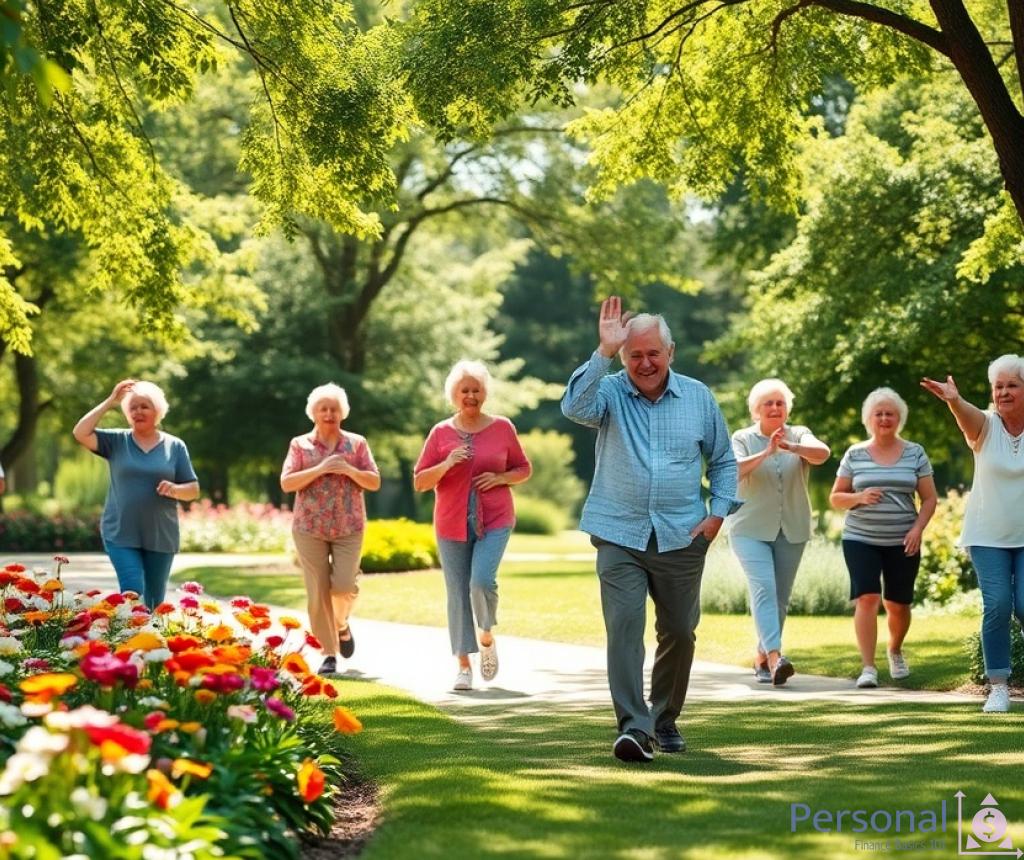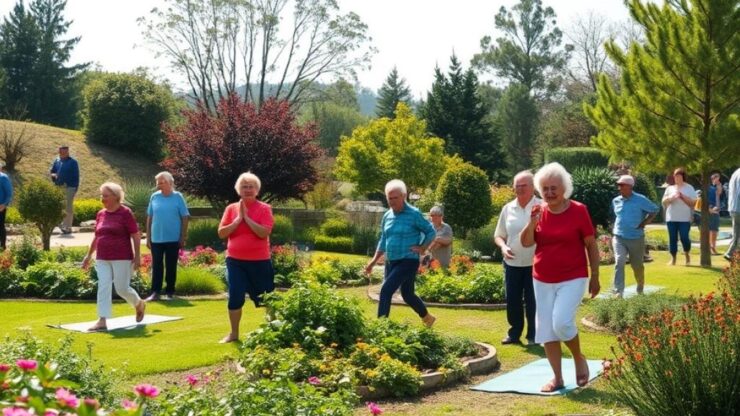Nutritional Strategies for Healthy Aging

As we age, our nutritional needs evolve, requiring a reevaluation of our dietary habits. A balanced diet is crucial for promoting longevity and ensuring overall well-being. Incorporating a variety of nutrient-dense foods can help maintain optimal health, support bodily functions, and prevent chronic diseases.
Essential nutrients play key roles in the aging process, including vitamins, minerals, proteins, and healthy fats. Making informed food choices can significantly impact quality of life during retirement years.
Understanding the essential nutritional elements that should dominate your plate can empower you to make healthier decisions. Here are some core nutritional elements to consider:
- Proteins: Vital for muscle preservation and repair, particularly as muscle mass tends to decline with age.
- Fiber: Supports digestive health and helps in maintaining a healthy weight.
- Healthy Fats: Such as omega-3 fatty acids, found in fish and flaxseeds, are crucial for brain health and reducing inflammation.
- Vitamins and Minerals: Key vitamins like B12, D, and calcium are essential for bone health and metabolic functions.
- Hydration: Adequate fluid intake is crucial, as the sense of thirst may diminish with age.
Developing a nutritional plan tailored to your specific needs can be a game-changer in your retirement journey. Here are some effective strategies to consider:
- Consult a Nutritionist: Professional guidance can help create a personalized dietary plan based on health status and lifestyle.
- Meal Prepping: Preparing meals in advance ensures that healthy options are readily available, reducing the temptation of unhealthy snacking.
- Mindful Eating: Focusing on the eating experience can enhance satisfaction and aid in digestion.
- Stay Active: Combine a nutritious diet with regular physical activity to enhance health benefits.
- Regular Check-ups: Monitoring health conditions can help adjust dietary needs as necessary.
Physical Activity Guidelines for Seniors

As we transition into retirement, staying physically active becomes more crucial than ever. Engaging in regular physical activity not only promotes physical health, but it also enhances mental well-being and overall quality of life. Understanding the appropriate activity levels and types for seniors can lead to a more vibrant and fulfilling retirement. It’s essential to consider personal preferences, physical limitations, and health conditions when establishing a routine.
The Centers for Disease Control and Prevention (CDC) outlines specific activity guidelines tailored for older adults. These recommendations emphasize the importance of incorporating both aerobic and strength-training exercises into one’s weekly routine. Aerobic activities, such as walking, swimming, or cycling, should be performed for at least 150 minutes a week, broken down into manageable sessions. This level of activity not only supports cardiovascular health but also improves endurance and energy levels.
In addition to aerobic exercise, it is vital to engage in muscle-strengthening activities on two or more days each week. These activities should target all major muscle groups, helping to maintain muscle mass and improve functional capacity. Examples include lifting weights, resistance band exercises, or even bodyweight workouts such as squats and push-ups. By adhering to these guidelines, seniors can work towards reducing the risk of falls and enhancing their ability to perform daily tasks independently.
Alongside aerobic and strength training, balance and flexibility exercises play a pivotal role in a senior’s fitness regimen. These activities help improve stability and prevent falls, which are a significant concern for older adults. Simple practices such as tai chi, yoga, or specific balance exercises can enhance coordination and body awareness. Flexibility exercises, including stretching, should also be integrated into the routine to promote better joint health and mobility.
Creating a balanced exercise program requires an understanding of one’s current fitness level and capabilities. Seniors are encouraged to start slowly, gradually increasing intensity and duration as their strength and endurance improve. It’s crucial to listen to one’s body and consult healthcare professionals before starting new exercise programs, especially for those with pre-existing health concerns.
| Activity Type | Frequency | Duration |
|---|---|---|
| Aerobic Exercise | 5 days a week | 30 minutes |
| Strength Training | 2 or more days a week | All major muscle groups |
| Balance Exercises | 3 or more days a week | 10-15 minutes |
In conclusion, embracing a well-rounded approach to physical fitness can significantly contribute to a healthier retirement. By adhering to established guidelines and focusing on a variety of exercises, seniors can enhance their strength, mobility, and overall health, paving the way for a more active and enjoyable lifestyle.
Mental Health Considerations in Retirement

As individuals transition into retirement, mental health emerges as a critical component of overall well-being. The shift from a structured work environment to a more flexible lifestyle can evoke a range of emotions, from excitement to anxiety. Understanding the nuances of mental health during this transformative phase can pave the way for a more fulfilling and balanced life.
The end of a career often signifies a major life change that can leave individuals feeling unmoored. Embracing this transition involves acknowledging feelings of loss or uncertainty while simultaneously exploring new opportunities. Many retirees find it beneficial to set realistic expectations for this new chapter. Engaging in hobbies, volunteering, or pursuing education can provide a sense of purpose and fulfillment, helping to ease the emotional turbulence that may arise.
Social connections are paramount for mental health, particularly during retirement. Maintaining relationships with family, friends, and community can significantly impact emotional well-being. Research indicates that social isolation can lead to depression and anxiety, making it essential to actively seek out social opportunities. Joining clubs, participating in community events, or simply scheduling regular catch-ups with friends can foster a sense of belonging and support. Moreover, engaging with others can stimulate cognitive functions and provide emotional resilience.
| Activity | Benefits |
|---|---|
| Volunteering | Enhances purpose and connection to community |
| Group Classes (e.g., art, fitness) | Promotes social interaction and physical health |
| Traveling | Encourages new experiences and personal growth |
Moreover, it is essential to recognize the signs of mental health challenges, such as prolonged sadness or withdrawal from activities. Seeking assistance from mental health professionals can provide invaluable strategies to cope with the emotional aspects of retirement effectively. Early intervention can lead to better outcomes, ensuring that mental health remains a priority.
Preventive Healthcare Measures for Retirees
As retirees embark on this new chapter of life, prioritizing health becomes paramount. Preventive healthcare measures can significantly enhance the quality of life during retirement years, allowing individuals to enjoy their newfound freedom with vigor and vitality. Proactive health management can lead to early detection of issues, potentially preventing serious complications down the road. Understanding and implementing these measures is crucial for fostering a healthy lifestyle.
One of the most effective strategies for preventive healthcare is regular health screenings. These assessments are essential for identifying potential health issues before they escalate. Common screenings for retirees include blood pressure checks, cholesterol levels, diabetes assessments, and cancer screenings such as mammograms and colonoscopies. Staying informed about personal health metrics can empower individuals to make informed decisions about their lifestyle and treatment options. Additionally, establishing a relationship with a primary care physician allows for tailored advice and ongoing monitoring of health conditions.
Another critical aspect of preventive healthcare is staying up-to-date with vaccinations. Immunizations play a vital role in protecting against diseases that can disproportionately affect seniors. The flu vaccine, shingles vaccine, and pneumococcal vaccines are particularly important for older adults, as these illnesses can lead to severe complications. Consulting with healthcare providers about necessary vaccinations can help retirees create a robust defense against preventable diseases. Moreover, maintaining a healthy lifestyle, including a well-balanced diet and regular exercise, complements the benefits of these immunizations, fostering an overall healthier immune system.
Preventive healthcare is not solely about physical wellness; mental and emotional health are equally important. Engaging in activities that stimulate the mind, such as reading, puzzles, or lifelong learning, can help keep cognitive functions sharp. Moreover, maintaining social connections is essential for emotional well-being. Regular interaction with peers, family, and community can mitigate feelings of loneliness and depression, which can be prevalent in retirement. Integrating preventive measures that address both physical and mental health can lead to a more fulfilling and balanced retirement experience. Seeking support from mental health professionals when needed is also a crucial component of comprehensive healthcare planning.
Social Engagement and Its Impact on Well-Being
In the journey of retirement, the importance of social engagement cannot be overstated. As individuals transition from structured work life to a more flexible schedule, maintaining interpersonal relationships becomes essential for mental and emotional health. Engaging in social activities fosters a sense of belonging and can significantly enhance overall well-being. Research shows that retirees who actively participate in community events or maintain regular contact with family and friends report higher levels of happiness and lower instances of depression.
Establishing a solid network of relationships is a vital component of a fulfilling retirement. Engaging with neighbors, joining clubs, or participating in volunteer work can create opportunities for socialization that may otherwise diminish. These interactions not only provide companionship but also stimulate the mind and promote an active lifestyle. Activities such as group exercise classes or book clubs can transform solitary moments into enriching experiences, combating feelings of isolation. The shared experiences and camaraderie found in these settings can lead to lasting friendships that contribute positively to mental health.
Moreover, the influence of social engagement extends beyond mere companionship; it can have profound effects on physical health as well. Studies indicate that seniors with robust social networks tend to have better cardiovascular health, lower blood pressure, and enhanced immune function. The act of socializing can encourage healthier lifestyle choices, such as increased physical activity and better dietary habits. As individuals come together, they inspire one another to adopt practices that contribute to a healthier lifestyle, illustrating the interconnectedness of social support and wellness. In essence, fostering social connections can serve as a protective factor against numerous health issues, ultimately enhancing quality of life during retirement.
Disclaimer
This article has been created or edited with the support of artificial intelligence and is for informational purposes only. The information provided should not be considered investment advice. Please seek the support of a professional advisor before making any investment decisions.






